
The Visconti of Milan are a noble Italian family. They rose to power in Milan during the Middle Ages where they ruled from 1277 to 1447, initially as Lords then as Dukes, and several collateral branches still exist. The effective founder of the Visconti Lordship of Milan was the Archbishop Ottone, who wrested control of the city from the rival Della Torre family in 1277.

The Sforza Castle is a medieval fortification located in Milan, northern Italy. It was built in the 15th century by Francesco Sforza, Duke of Milan, on the remnants of a 14th-century fortification. Later renovated and enlarged, in the 16th and 17th centuries it was one of the largest citadels in Europe. Extensively rebuilt by Luca Beltrami in 1891–1905, it now houses several of the city's museums and art collections.
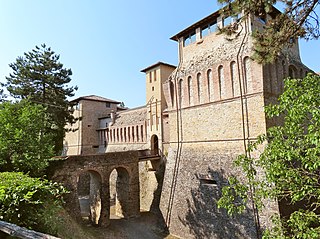
Felino is a comune (municipality) in the Province of Parma in the Italian region Emilia-Romagna, located about 90 kilometres (56 mi) west of Bologna and about 13 kilometres (8 mi) southwest of Parma. As of 2011 it had a population of 8,621.

Langhirano is a comune (municipality) in the Province of Parma in the Italian region Emilia-Romagna, located about 90 kilometres (56 mi) west of Bologna and about 20 kilometres (12 mi) south of Parma.

San Ginesio is a comune (municipality) in the Province of Macerata in the Italian region Marche, located about 60 kilometres (37 mi) southwest of Ancona and about 25 kilometres (16 mi) southwest of Macerata. As of December 31, 2004, it had a population of 3,872 and an area of 77.7 square kilometres (30.0 sq mi).
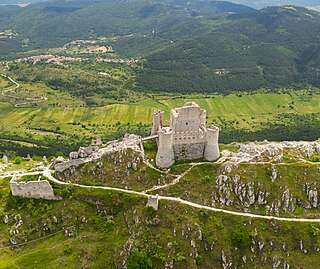
The Castle of Rocca Calascio is a mountaintop fortress or rocca in the municipality of Calascio, in the Province of L'Aquila, Abruzzo, Italy.
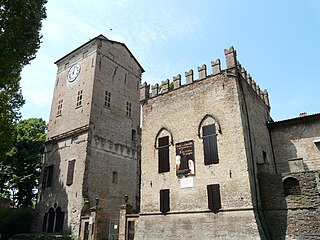
Rocca dei Rossi is a castle located at piazza Mazzini #12 in the town of San Secondo Parmense, province of Parma, in the Italian region Emilia-Romagna. A different Rocca dei Rossi, also known as Castello di Roccabianca, is located in the town of Roccabianca.
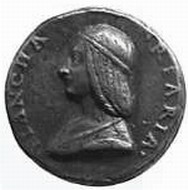
Bianca Riario was an Italian noblewoman and regent, Marchioness of San Secondo by marriage to Troilo I de' Rossi, and regent of the marquisate and county of San Secondo for her son Pier Maria during his minority between 1521 and 1522. She was the eldest child and only daughter of Caterina Sforza by the latter's first husband, Girolamo Riario, a nephew of Pope Sixtus IV.

The Castello or Castle of Roccabianca, also called Rocca dei Rossi, is a castle built in the town of Roccabianca, province of Parma, Emilia Romagna, northern Italy.

Pier Maria Rossi or Pier Maria II de' Rossi was an Italian condottiere and count of a region around present San Secondo Parmense. His properties included the castle of Rocca dei Rossi. He was known as "the Magnificent".

Visconti Park was the private park of the Visconti and Sforza families, lords, and dukes of Milan. Located in Lombardy, northern Italy, it extended between Pavia Castle and the Certosa di Pavia monastery. It covered an area of about 2,200 hectares (22 km2) and was encircled by walls about 25 kilometres (16 mi) in length. It was founded in 1360 by Galeazzo II Visconti and enlarged by his son Gian Galeazzo.
Angela Paola de' Rossi was an Italian noblewoman. She was born to Troilo I de' Rossi and Bianca Riario in San Secondo Parmense. Her first husband was Vitello Vitelli; they married in 1522. After Vitello's death in 1528, she married Alessandro Vitelli. Both husbands were from the Vitelli family. She died in Città di Castello.
Troilo I de' Rossi was an Italian condottiero and the first marquess of San Secondo.
Giovanni de' Rossi was an Italian condottiero and the fifth count of San Secondo. He was nicknamed 'il diseredato'.
Guido de' Rossi was an Italian condottiero.
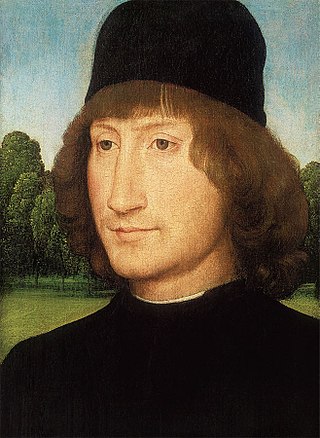
Sforza Secondo Sforza was an Italian condottiero.

The Visconti Castle of Abbiategrasso is a medieval castle in Abbiategrasso, Lombardy, northern Italy. It was among the first Visconti castles built according to their typical quadrangular layout. In the 14th and 15th centuries, it was one of the preferred residences of the duchesses of Milan of the Visconti and Sforza houses. Today, the castle's surviving part serves as the seat of the municipality of Abbiategrasso.

The Abbey of St Mary of the Snows is a Benedictine Monastery and church, located in a rural spot on Via Badia #28 in the frazione of Torrechiara and its castle, in the town limits of Langhirano, Province of Parma, Italy. The monastery is affiliated with the monastery of San Giovanni Evangelista, Parma.
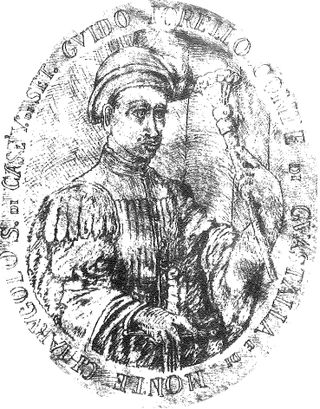
Guido Torelli was a condottiero. Through his military campaigns and diplomatic skills, he achieved the title of the first Count of Guastalla and Montechiarugolo.

















